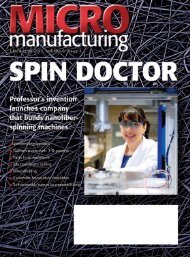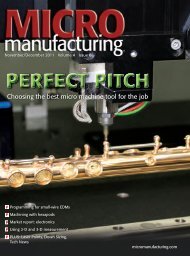Click here to view as PDF - MICROmanufacturing
Click here to view as PDF - MICROmanufacturing
Click here to view as PDF - MICROmanufacturing
Create successful ePaper yourself
Turn your PDF publications into a flip-book with our unique Google optimized e-Paper software.
ABOUT<strong>to</strong>oling<br />
Accurate <strong>to</strong>ol registration boosts precision<br />
16 | MARCH/APRIL 2010 | <strong>MICROmanufacturing</strong><br />
New technology is permitting the consistent<br />
production and application of<br />
micro<strong>to</strong>ols down <strong>to</strong> 10μm in diameter and<br />
smaller. Tool and die shops are using these<br />
<strong>to</strong>ols <strong>to</strong> create microfeatures in hard and difficult-<strong>to</strong>-machine<br />
materials. One challenge<br />
in applying micro<strong>to</strong>ols, however, is their registration<br />
with respect <strong>to</strong> the workpiece. To<br />
prevent <strong>to</strong>ol breakage and meet <strong>to</strong>lerances,<br />
proper registration must be maintained.<br />
Microlution<br />
A Blum l<strong>as</strong>er <strong>to</strong>ol setter mounted on a Microlution<br />
5100-S machine <strong>to</strong>ol.<br />
Obviously, the old trick of pinching a piece<br />
of paper between the <strong>to</strong>ol and workpiece is<br />
not effective in the microworld. These small,<br />
fragile <strong>to</strong>ols are difficult <strong>to</strong> <strong>view</strong>, even with<br />
an optical microscope. As a result, new me<strong>as</strong>urement<br />
strategies are required. A combination<br />
of workpiece probing and <strong>to</strong>ol setting<br />
can provide an effective approach <strong>to</strong> achieving<br />
precise registration.<br />
Applying <strong>to</strong>ol setters<br />
A way <strong>to</strong> optimize precision in micromachining<br />
is <strong>to</strong> apply <strong>to</strong>ol setters that allow onmachine<br />
<strong>to</strong>ol location and size me<strong>as</strong>urement.<br />
However, not all <strong>to</strong>ol setters are useful for<br />
microapplications.<br />
The challenges of using <strong>to</strong>ol setters in<br />
micromachining must be unders<strong>to</strong>od within<br />
the context of spindle speed requirements.<br />
It’s typical <strong>to</strong> use pressurized air-bearing<br />
spindles that operate at speeds from 60,000<br />
<strong>to</strong> 250,000 rpm. These spindles can produce<br />
high error motions due <strong>to</strong> their relatively low<br />
stiffness. Hybrid ball bearing spindles have<br />
a stiffness of around 60 new<strong>to</strong>n/μm, while<br />
high-speed air bearing spindles can have a<br />
stiffness <strong>as</strong> low <strong>as</strong> 1 new<strong>to</strong>n/μm. These conditions,<br />
combined with misalignment of the<br />
<strong>to</strong>ol in the collet, can produce <strong>to</strong>ol runouts<br />
from 1μm <strong>to</strong> 10μm, and these values can vary<br />
with spindle speed and <strong>to</strong>ol changes. Me<strong>as</strong>uring<br />
the <strong>to</strong>ol diameter at zero speed will<br />
not provide useful calibration information.<br />
Ideally, the spindle should be operating at full<br />
speed during me<strong>as</strong>urement and should not<br />
s<strong>to</strong>p before engaging the workpiece.<br />
To address this issue, several companies<br />
have introduced noncontact, high-resolution<br />
l<strong>as</strong>er <strong>to</strong>ol setters for micromanufacturing (see<br />
pho<strong>to</strong>, left). These <strong>to</strong>ol setters can me<strong>as</strong>ure<br />
with the spindle operating at up <strong>to</strong> 150,000<br />
rpm. Integral air jets on some <strong>to</strong>ol setters<br />
keep cutting <strong>to</strong>ols clean. This can be vital for<br />
me<strong>as</strong>urement because chips and dirt particles<br />
can be nearly <strong>as</strong> large <strong>as</strong> the <strong>to</strong>ol itself.<br />
Solvents such <strong>as</strong> isopropyl alcohol or ace<strong>to</strong>ne,<br />
combined with an air bl<strong>as</strong>t, can effectively remove<br />
fluids and particles.<br />
One disadvantage of l<strong>as</strong>er <strong>to</strong>ol setters is<br />
they only detect <strong>to</strong>ol diameter and position in<br />
one direction. Typically, the <strong>to</strong>ol setter is oriented<br />
<strong>to</strong> me<strong>as</strong>ure in a direction that is planar<br />
with the structural loop of the machine <strong>to</strong>ol<br />
(typically the Y-axis). Due <strong>to</strong> thermal variations,<br />
this direction experiences more displacement,<br />
for which the <strong>to</strong>ol setter must<br />
compensate.<br />
The entire perimeter of a <strong>to</strong>ol is used during<br />
milling, and me<strong>as</strong>uring <strong>to</strong>ol runout in<br />
all directions is important. It is a misnomer<br />
that once <strong>to</strong>ol runout is me<strong>as</strong>ured in one direction<br />
it is the same in all directions. This is<br />
the c<strong>as</strong>e for collet-placement errors, but not<br />
spindle rotation errors. Spindles can scribe<br />
a multilobed profile <strong>as</strong> they rotate, and this















